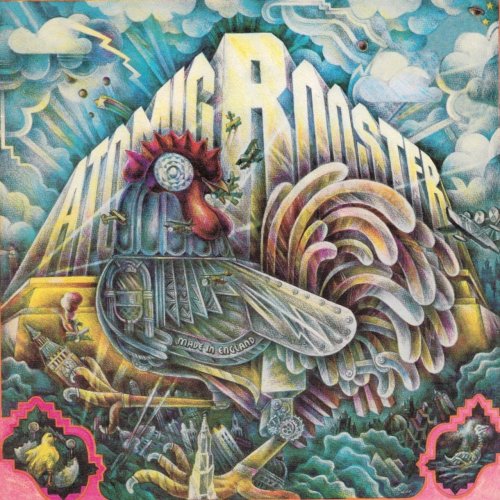More here.
Archive for the 'Album Covers' Category
Abe Gurvin Album Covers, 1967 – 1977
Published March 22, 2016 '60s Decor/Design/Fashion , Album Covers , Psychedelic Art , Records (LPs) and Cassettes Leave a CommentThe Art of Shusei Nagaoka: Electric Light Orchestra’s Out of the Blue (1977)
Published January 8, 2016 Album Covers , Sci-Fi/Space Art , Shusei Nagaoka , Spaceship Command Centers/Bridges/Cockpits 4 CommentsShusei Nagaoka (1936-2015) was responsible for much of the shimmering and gorgeous sci-fi art of the 1970s and 1980s, a sampling of which can be seen at Pink Tentacle. The fourth image appeared on the interior of the LP, and shows the command center located under the ELO logo on the cover. Much like my obsession with dead astronaut art, I’m fascinated by renderings of spaceships, especially spaceship interiors, especially command centers. These pieces tell us quite a bit about how space travel and future life were perceived at the time. Nagaoka here plays on the similarities between records and flying saucers: all is color and warmth and shiny surfaces, a meandering jukebox with warp drive in a laser light show universe.
If you see either volume of The Works of Shusei Nagaoka for a reasonable price, grab it up.
(Some images via Pink Tentacle and First Draft)
Space Hymns by Ramases (Vertigo, 1971)
Published June 11, 2015 Album Covers , Psychedelic Music Leave a CommentA neglected space-rock classic, Space Hymns (on Spotify) is the brainchild of Sheffield-born Barrington Frost (sometimes misreported as Martin Raphael), an erstwhile central heating salesman who, in the late ’60s, had a revelation that he was actually the reincarnation of one of the 11 Egyptian pharaohs named Ramses (it’s unclear which one).
The music is driven by Ramases’ always present acoustic guitar, strong melodies and vocals (some contributed by Ramases’ wife, Selket), and lots of space in between the multilayered swirling. It’s also sludgy at times, and uses drone to achieve an ambient effect, especially on “Molecular Delusion”. “Journey to the Inside,” while obviously influenced by The Beatles’ “Tomorrow Never Knows,” anticipates the kind of sonic experimentation Roger Waters would use on Dark Side of the Moon. Backing musicians for the Space Hymns recording sessions went on to form the successful UK art rock band 10cc.
Ramases’ second and last album, Glass Top Coffin (1975), is better than the first, in my opinion: trippier but also more focused, with stronger production and gorgeous arrangements—a near perfect translation of the inner-outer space excursion.
The Space Hymns album cover is a six-panel gatefold, by the way, painted by the master, Roger Dean.
In Search of the Lost Chord by The Moody Blues (Deram, 1968)
Published April 1, 2015 Album Covers , Psychedelic Music 8 CommentsPsychedelic music is intrinsically navel-gazey because it expresses the individual’s inner journey, the mystical expedition. Often, the effort is too pretentious and silly to bear, and laughter ensues. Sometimes the opposite occurs, and you get the feeling that you’ve been lifted to a higher plane. I’m not a great Moody Blues fan, and In Search of the Lost Chord is no Fifth Dimension, but I really like the album: it’s lush and soft, not particularly ground-breaking but particularly dreamy and pleasant.
Why am I writing about psychedelic music? Because I dig it, and because it’s intimately related to the explosion of the fantasy and sci-fi scene in the late ’60s, not to mention surging interest in the occult (or “metaphysics”) and mythology, all of which inform early geek culture.
The LP cover art is by Phil Travers, who recounts the experience—“the band wanted me primarily to illustrate the concept of meditation”—at Rock Pop Gallery.
Meco’s Music from Star Trek and The Black Hole (1980)
Published February 5, 2014 '70s Music , Album Covers , Black Hole, The , Records (LPs) and Cassettes , Space Disco , Star Trek , Star Wars (Original Trilogy) 12 CommentsMeco (Domenico Monardo) launched the space disco era with Star Wars and other Galactic Funk (1977), which went platinum. He followed with several disco-ized soundtrack albums, including Encounters of Every Kind (1977), Superman and other Galactic Heroes (1978), and Christmas in the Stars: Star Wars Christmas Album (1980).
Music from Star Trek and The Black Hole (1980) didn’t go over well. The movies bombed at the box office, and the original, now classic soundtracks (by Jerry Goldsmith and John Barry, respectively), resisted the transition to upbeat funk. Meco knew it, and faked most of The Black Hole. The main theme is the only track that clearly resembles Barry’s score.
You can listen to Meco’s “Star Trek Medley” here. The entire Black Hole suite is below.
The album art is by Shusei Nagaoka, who did many memorable sci-fi-themed covers throughout the ’70s, including Out of the Blue (ELO) and Raise! (Earth, Wind & Fire).
A German group called Nostromo, following a very curious disco version of the Alien theme in 1979, released a 7″ called The Black Hole in 1980. It’s much more faithful to the original, although I like Meco’s misdirected space-funk a little bit more.
Giorgio Moroder’s Music from “Battlestar Galactica” and Other Original Compositions (1978)
Published January 15, 2014 '70s Music , Album Covers , Battlestar Galactica , Records (LPs) and Cassettes , Space Disco 5 CommentsThe collision of silver age sci-fi and disco was either Western civilization’s final, total surrender to decadence, or one of our finest moments. Or was it both?
Listen to side one—all the BSG music—here. Side two—“Evolution,” a Moroder classic—is here.
The LP cover artist is Winston Taylor.
(Image via Tuk Tuk)
Album Covers: Somewhere in Time by Iron Maiden (1986)
Published July 17, 2013 '80s Music , Album Covers , Records (LPs) and Cassettes 8 CommentsI really wanted to buy this album so I could stare at the fucking fantastic wrap-around cover all day long (click image to enlarge), but in 1986 I was in the punk and post-punk club, and clubs didn’t mix. We listened to Metallica’s Master of Puppets while skateboarding, but that was the extent of my metal intake.
The artist is Derek Riggs, who painted all of Iron Maiden’s ’80s album covers and created Eddie the Head, the grisly mascot who appears in Maiden artwork in different guises. Riggs says of Somewhere in Time:
This is the most complex album cover ever done by anyone… and I’m not going to do it again. It’s too much fucking work. This may be the biggest version that some of you have ever seen. there’s tons of stuff in here, you will have to look and find it for yourself. There’s more about the painting of this in the book “Run for Cover” which is available from my website. They said they wanted something a bit Bladerunner looking so I painted this.
Riggs’ covers for the singles are below as well.
P.S. I’m going back and listening to Iron Maiden’s catalog, starting from the beginning. (Thanks for the reminder, Jason.)
Album Covers: It’s Hard by The Who (1982)
Published June 21, 2013 '80s Music , Album Covers , Arcade Cabinets/Coin-Ops , Atari , Records (LPs) and Cassettes , Video Games 4 CommentsI don’t think this was the first video game to make it onto an album cover (I’m looking into it), but it’s awesome nevertheless.
(Images via eBay)






























